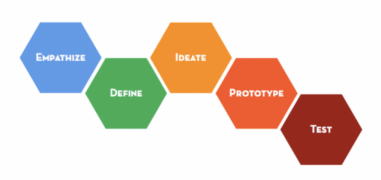Design Thinking for Robotics and Life
by David Kohanbash on June 13, 2016

Hi all
Recently I went to a seminar about design thinking. Design thinking is an approach to solving a problem from any domain. During the seminar people used design thinking to analyze how to automate password recovery, lead a finance team, build an activities team, and others. I used this as an exercise to look at how to teach Jr. team members to test robots.
Before we start looking at design thinking there are several key mindsets that should be embraced:
- Show Don’t Tell – Create experiences and visuals
- Craft Clarity – Produce a coherent vision
- Be Mindful of Process – Know where in the design process you are at
- Radical Collaboration – Bring together people of different backgrounds
- Bias Towards Action – Do something!
- Embrace Experimentation – Prototyping is important
- Focus on Human Values – Empathy for people you are designing for

Sample process looking at improving field testing for Jr. Staff. Click for a larger version. (I know I have bad handwriting)
There are 5 stages in the design thinking process. Here they are:
- Empathize
- Define
- Ideate
- Prototype
- Test
This is the foundation of human focused design. See what your users need/want and talk to them. This is where you can better define the problem.
This is where you can define more details for the problem observed. This lets you unpack the problem above into its individual components. In many cases the real question will show up in this step; as you know getting the proper question is often the hard part.
“If I had an hour to solve a problem and my life depended on the solution, I would spend the first 55 minutes determining the proper question to ask, for once I know the proper question, I could solve the problem in less than five minutes.” – Albert Einstein
This is the step where we explore possible solutions to the problems defined. In this step you can explore a wide space of possible solutions.
In this step we can take some solutions from the Ideate step and come up with a possible real solution that we want to implement. This is the step where you can take ideas in your head and turn it into reality.
Finally we can test our prototype solution. Testing can take many forms including asking users to evaluate it and showing it to other experts. This is your chance to actually evaluate if your empathize step was correct. This also lets you test your prototype to see you how you need to iterate on the design.
Capturing each step on sticky notes provides a flexible way to organize and reorganize your thoughts. If nothing else it makes for a prettier picture than a whiteboard. You should only put 1 idea per sticky note.
For more details see the An Introduction to Design Thinking PROCESS GUIDE.
I hope you found this interesting. Many of us do a modified version of the above by default. But it is sometimes nice to see this formal method, especially when you are working with a group and trying to come up with a common solution.
If you have other tools you use for solving problems, leave it in the comments below.
Primary Resource: Stanford d.school.
Main image from http://dschool.stanford.edu/dgift/


Comments
I was missing the connection of this to robotics, as indicated in the title.
Thanks for reading.
This is a method of thinking that can be used for designing robots or any other system. The same as when I write about using GPS or motor controllers. They are topics of use for roboticists.